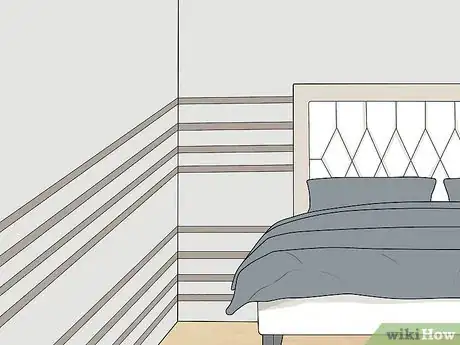This article was co-authored by Julie Naylon. Julie Naylon is the Founder of No Wire Hangers, a professional organizing service based out of Los Angeles, California. No Wire Hangers provides residential and office organizing and consulting services. Julie's work has been featured in Daily Candy, Marie Claire, and Architectural Digest, and she has appeared on The Conan O’Brien Show. In 2009 at The Los Angeles Organizing Awards she was honored with “The Most Eco-Friendly Organizer”.
There are 8 references cited in this article, which can be found at the bottom of the page.
This article has been viewed 181,352 times.
A Zen bedroom is one that is most conducive to sleeping. You can be at peace in your room, fall asleep easier, and rest soundly through the night. By cleaning out, decorating, and coming to your bedroom ready for a peaceful night, you can begin to have better sleep and feel more at ease.
Steps
Organizing Your Room for More Zen
-
1Declutter your visible surfaces. Visual clutter translates to mental clutter.[1] Having a clean space to rest is the first step to feeling more at ease when you go to bed, and this goes for all of your surfaces—floors, desks, walls, etc.[2]
- Put clothes from the floor in the closets, drawers, or hamper. Give the floor a little sweep every week as well for that extra clean feeling under your feet.
- Arrange and file papers on your desk.[3] Loose pens, messy makeup, or other types of clutter need to be put up or away. Get a “change bowl” for you to put your keys, headphones, or loose articles without a place so that they still feel organized, too.
- Only keep what you need to get through the night on your bedside table.[4] That means a glass of water and maybe a tissue.
- Swap out your phone’s alarm for a conventional alarm clock. This will reduce the urge to use your phone before bed or during the night. Move your phone charger across the room or into the bathroom, for example.
-
2Arrange your bed away from but facing the door. Feng shui dictates that your bedroom’s “commanding position” of the bed is farthest away from the door. The “command position” is the place in the room where you’re most ready to deal with whatever comes your way, literally and figuratively. If distance is not achievable, at least position your bed so it faces the door to create a feeling of security and safety.[5]
- Don’t forget you can position your bed in a corner if you have space. This supposedly offers better chi by not aligning the bed with the entrance to the room.
- If you have a window, position the bed to where you can see both the door and the window—unless you aren’t on the ground floor. Then it is still a safe feeling to put the headboard at the window. Don’t totally block your natural daylight, though!
Advertisement -
3Move other furniture away from the middle of the room. Having a more open floor plan in the bedroom helps in feeling less cluttered, just like a clean desktop. The easier it is to move in the room, the more comfortable it will feel.[6]
- To save work, practice by drawing different arrangements before starting to move the furniture.
- Do not block out windows or doors in order to make distance with furniture. Instead, consider removing a piece of furniture to another room if it is too crowded. Less is more!
- Try to center pieces of furniture on their respective walls. This helps to keep corners and walkways from getting too cramped.
- Moving furniture around from time to time is always a great idea to renovate the space and give it a fresh take.[7]
-
4Block out as much light and noise as possible at night. Sleep is best done in the quiet, peaceful darkness. Opt for blackout curtains on the windows that will not only keep out light but insulate from extra noise.[8]
- Closing the door when you go to bed will also make sure that anyone else in the hall or room next to you doesn’t unintentionally wake you up.
- If you live in a noisy part of town or near an active roadway, try a white noise machine or swiveling fan to counteract some of the noise.
- If you like to wind down at the end of the day to TV, do so in another room. You don’t want to leave the TV on overnight or associate your room with being awake.
- During the day, open the blinds. Let in natural daylight, if you can, over artificial lighting.[9]
Decorating a Zen Bedroom
-
1Choose earth-tones or light blues and greens when decorating. Another feng shui suggestion is to go with tan, copper, coral, cream, or similar feeling colors when painting and decorating the room. Light blues and greens work as well to create a feeling of calmness without making the room feel too dark.[10]
- Shades of blue are considered the most psychologically calming color to humans.
- Reds and pinks can promote romance, but they also have a restless feeling to them. Only use these colors for accents or small pieces that can be put away.
-
2Pick light and natural fabrics to use. Quality, organic (where possible) linens are ideal to sleep in. It will increase your desire to go to bed, and it will help prevent you from sweating or itching during sleep.[11]
- Choose linen or wool curtains to help with light, noise, and breezes. Make sure they match the color of the room, though.
- Pay attention to the curtain’s hanging hardware as well. The details and accents should blend cleanly into the environment so as not to draw notice. For example, use silver accents on a lighter colored wall, or if you have dark curtains, you might opt for black or bronze hardware.
-
3Add a live plant to your room if you get sunlight. Plants bring a little piece of nature inside, and they can help clean the air at the same time. The transfer of carbon dioxide into fresh, clean oxygen will make the room feel more peaceful.[12]
- Popular zen plants include Bonsai trees, philodendron, Sansevieria, and succulents.[13]
- Do not forget to water and provide light per your plant’s instructions.
- The act of taking care of the plant itself can be a form of meditation.
- Opt for a plant that does not have a strong odor to it, as well. The extra scent may become distracting when you try to fall asleep.
-
4Keep decor to a minimum. Clutter is chaos, and the same goes with wall-hangings or busy shelves. Instead, put your photos and busier artifacts in a living room to spark conversation.[14]
- Shelves to hold your plants or a simple tapestry can be appropriate additions that don’t draw too much attention or unnecessary energy.
- Do not hang mirrors in the room either. They create active energy that opposes the peaceful feeling of sleep. Hide them in a closet or leave them in the bathroom.
- Don’t have anything hanging above your bed either. You may believe that the shelf is firmly in place, but it still creates an uneasy feeling subconsciously every time you lay down beneath it.
Changing Habits to Bring the Zen
-
1Ditch the electronics at least 30 minutes before bed. Looking at a bright TV, phone, or computer screen before trying to fall asleep makes it physically more difficult. Do some reading or your bedtime routine without your screens.[15]
- Unless your phone is also your alarm clock (which you can change), try leaving it charging overnight in the bathroom or kitchen. This helps remove the temptation of doing some bedtime surfing.
- Having screens in the bedroom associate the space with being awake and active. When you remove them, your brain will associate your bedroom only as a place to rest.
-
2Try 10-15 minutes of meditation before bed. Meditation helps you to release some of the stresses of your day. Recentering your mind in this way will allow you to sleep more peacefully. It actually creates physiological responses similar to those at the beginning of sleep.[16]
- Sit up in bed or in an armchair in your bedroom, close your eyes, and just listen to the silence around you. Feel the stresses or anxieties of your day leave your body before you lie down to rest.
- Avoid pairing meditation with yoga just before bed. The added physical movement wakens your body more than rests it. Try yoga and meditation first thing in the morning!
- When meditating, try not to plan tomorrow or rehash the day you’ve just had. Let your mind go, and let your stress go.
-
3Keep your bedroom temperature cool. The best temperatures for sleep are between 60 and 68 °F (16 and 20 °C). Even in the winter, a cooler room will be more conducive to rest than a warm one. Negotiate a few degrees of cooler temperature with a more insulated blanket.[17]
- If a thermostat is not available to adjust, try using a fan. The additional white noise will help you to fall asleep easier, too.
- If you live in a quiet enough area, cracking the door and window can help draw a breeze through your room to cool it down.
-
4Aim to sleep on your side for good digestion. Lying on your side is the best for aiding good sleep and digestion. Lying on your back tends to encourage snoring and sore necks, while lying on your tummy can inhibit breathing and place pressure on your stomach region, preventing easy digestion.[18]
- If you’re typically a back or stomach sleeper, try placing a pillow behind your back (or in front of you if you tend to roll to your stomach) when you get on your side. This will help keep you propped sideways throughout the night.
- Bend one of your knees up slightly when you are on your side to provide additional support so that you don’t roll one way or the other in the night.
Expert Q&A
-
QuestionHow can I make my bedroom more calming?
 Katherine TlapaKatherine Tlapa is an interior designer, currently working as a Design Specialist for Modsy, a design service based in San Francisco. She also runs her own DIY Home Design blog, My Eclectic Grace. She received her BFA in Interior Architecture from Ohio University in 2016.
Katherine TlapaKatherine Tlapa is an interior designer, currently working as a Design Specialist for Modsy, a design service based in San Francisco. She also runs her own DIY Home Design blog, My Eclectic Grace. She received her BFA in Interior Architecture from Ohio University in 2016.
Interior Designer You can start by decluttering your space. Less clutter along with calm colors can help. Colors like light blue, white, and pastels can be calming. Avoid oversaturated wall paint. Good lighting helps as well, using string lights or secondary lamps is essential for a calm space.
You can start by decluttering your space. Less clutter along with calm colors can help. Colors like light blue, white, and pastels can be calming. Avoid oversaturated wall paint. Good lighting helps as well, using string lights or secondary lamps is essential for a calm space. -
QuestionWhat is the color of Zen?
 Katherine TlapaKatherine Tlapa is an interior designer, currently working as a Design Specialist for Modsy, a design service based in San Francisco. She also runs her own DIY Home Design blog, My Eclectic Grace. She received her BFA in Interior Architecture from Ohio University in 2016.
Katherine TlapaKatherine Tlapa is an interior designer, currently working as a Design Specialist for Modsy, a design service based in San Francisco. She also runs her own DIY Home Design blog, My Eclectic Grace. She received her BFA in Interior Architecture from Ohio University in 2016.
Interior Designer Zen doesn't have just one color, but tones of light blue, green, grey and shades of white are all considered to be colors that will make a space zen. The less saturated the color is, the better.
Zen doesn't have just one color, but tones of light blue, green, grey and shades of white are all considered to be colors that will make a space zen. The less saturated the color is, the better. -
QuestionWhat is the meaning of Zen?
 Katherine TlapaKatherine Tlapa is an interior designer, currently working as a Design Specialist for Modsy, a design service based in San Francisco. She also runs her own DIY Home Design blog, My Eclectic Grace. She received her BFA in Interior Architecture from Ohio University in 2016.
Katherine TlapaKatherine Tlapa is an interior designer, currently working as a Design Specialist for Modsy, a design service based in San Francisco. She also runs her own DIY Home Design blog, My Eclectic Grace. She received her BFA in Interior Architecture from Ohio University in 2016.
Interior Designer The dictionary defines zen as "a Japanese school of Mahayana Buddhism emphasizing the value of meditation and intuition."
The dictionary defines zen as "a Japanese school of Mahayana Buddhism emphasizing the value of meditation and intuition."
References
- ↑ Julie Naylon. Professional Organizer. Expert Interview. 18 December 2019.
- ↑ https://freshome.com/2012/12/31/how-to-make-your-home-totally-zen-in-10-steps/
- ↑ Julie Naylon. Professional Organizer. Expert Interview. 18 December 2019.
- ↑ Julie Naylon. Professional Organizer. Expert Interview. 18 December 2019.
- ↑ https://www.hgtv.com/design/rooms/bedrooms/feng-shui-your-bedroom-pictures
- ↑ https://freshome.com/2012/12/31/how-to-make-your-home-totally-zen-in-10-steps/
- ↑ Julie Naylon. Professional Organizer. Expert Interview. 18 December 2019.
- ↑ https://freshome.com/2012/12/31/how-to-make-your-home-totally-zen-in-10-steps/
- ↑ https://freshome.com/2012/12/31/how-to-make-your-home-totally-zen-in-10-steps/
- ↑ https://www.hgtv.com/design/rooms/bedrooms/feng-shui-your-bedroom-pictures
- ↑ https://freshome.com/2012/12/31/how-to-make-your-home-totally-zen-in-10-steps/
- ↑ https://freshome.com/2012/12/31/how-to-make-your-home-totally-zen-in-10-steps/
- ↑ https://www.mindbodygreen.com/0-23748/8-nofuss-houseplants-to-add-some-zen-to-your-space.html
- ↑ https://freshome.com/2012/12/31/how-to-make-your-home-totally-zen-in-10-steps/
- ↑ https://www.purewow.com/home/how-to-make-your-bedroom-zen
- ↑ https://sleep.org/articles/how-to-meditate-before-bed/
- ↑ https://www.nytimes.com/2009/08/04/health/04real.html
- ↑ https://sleep.org/articles/best-sleep-position/








































































